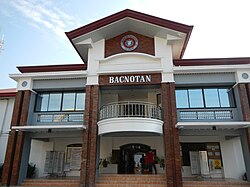Bacnotan
Bacnotan | |
|---|---|
Municipalidad | |
 | |
 Mapa de La Union con Bacnotan resaltado | |
 | |
| Coordenadas: 16°43'10.88"N, 120°20'53.11"E | |
| Nación | Filipinas |
| Región | Región de Ilocos (Región I) |
| Provincia | La Union |
| Número de barangay | 47 |
| Gobierno | |
| • Type | consejo municipal |
| • Electorado | Error en la secuencia de órdenes: la función «getValue» no existe. votantes (9 Mayo 2022) |
| Superficie | |
| • Total | 76,60 km2 (29,58 sq mi) |
| Elevation | 22 m (72 ft) |
| Populación (1 Mayo 2020) | |
| • Total | 44,388 |
| • Densidad | 0,58/km2 (1,5/sq mi) |
| • Hogares | 11,675 |
| Economía | |
| • Clase de ingresos | el primera clase de municipalidad |
| • Incidencia de la pobreza | Error en la secuencia de órdenes: la función «getValue» no existe.% (Error: fecha y hora no válidas.)[2] |
| • Ingresos | ₱ <strong4a4df3e5">Error (Error: fecha y hora no válidas.) |
| • Activos | ₱ <strong4a4df3e5">Error (Error: fecha y hora no válidas.) |
| • Pasivos | ₱ <strong4a4df3e5">Error (Error: fecha y hora no válidas.) |
| • Gastos | ₱ <strong4a4df3e5">Error (Error: fecha y hora no válidas.) |
| Huso horario | UTC+8 (PST) |
| Código postal | 2515 |
| PSGC | |
| Código telefonico | 72 |
| Lenguaje nativo | ilocano Tagalog |
| Website | http://www.bacnotan.gov.ph/ |
Bacnotan el primera clase de municipalidad na provincia de La Union, Filipinas. Tiene este zona de 76.60 kilometro cuadrado.
Comporme del 1 Mayo 2020 censo este tiene papulidad de 44,388 personas y 11,675 hogares. El designada codigo postal 2515 y PSGC 013303000.
Barangay
revisa
|
|
|
Demografía
revisa| Año | Populación | ±% p.a. |
|---|---|---|
| 1903 | 8883 | — |
| 1918 | 11 619 | +1.81% |
| 1939 | 11 678 | +0.02% |
| 1948 | 13 793 | +1.87% |
| 1960 | 15 859 | +1.17% |
| 1970 | 21 031 | +2.86% |
| 1975 | 23 126 | +1.92% |
| 1980 | 24 800 | +1.41% |
| 1990 | 29 568 | +1.77% |
| 1995 | 32 634 | +1.87% |
| 2000 | 35 419 | +1.77% |
| 2007 | 38 743 | +1.24% |
| 2010 | 40 307 | +1.45% |
| 2015 | 42 078 | +0.82% |
| 2020 | 44 388 | +1.06% |
| Ref: Autoridad de Estadísticas de Filipinas[3][4][5][6] | ||
Referencias
revisa- ↑ «Province: La Union». PSGC Interactive. Quezon City, Philippines: Philippine Statistics Authority. Consultado el Diciembre 17, 2016.
- ↑ «PSA Releases the 2021 City and Municipal Level Poverty Estimates» (2 Abril 2024).
- ↑ Census of Population (2015). "Region I (Ilocos Region)". Total Population by Province, City, Municipality and Barangay. Philippine Statistics Authority.
- ↑ Census of Population and Housing (2010). "Region I (Ilocos Region)". Total Population by Province, City, Municipality and Barangay. NSO.
- ↑ Censuses of Population (1903–2007). "Region I (Ilocos Region)". Table 1. Population Enumerated in Various Censuses by Province/Highly Urbanized City: 1903 to 2007. NSO.
- ↑ «Province of La Union». Municipality Population Data. Local Water Utilities Administration Research Division. Consultado el Diciembre 17, 2016.